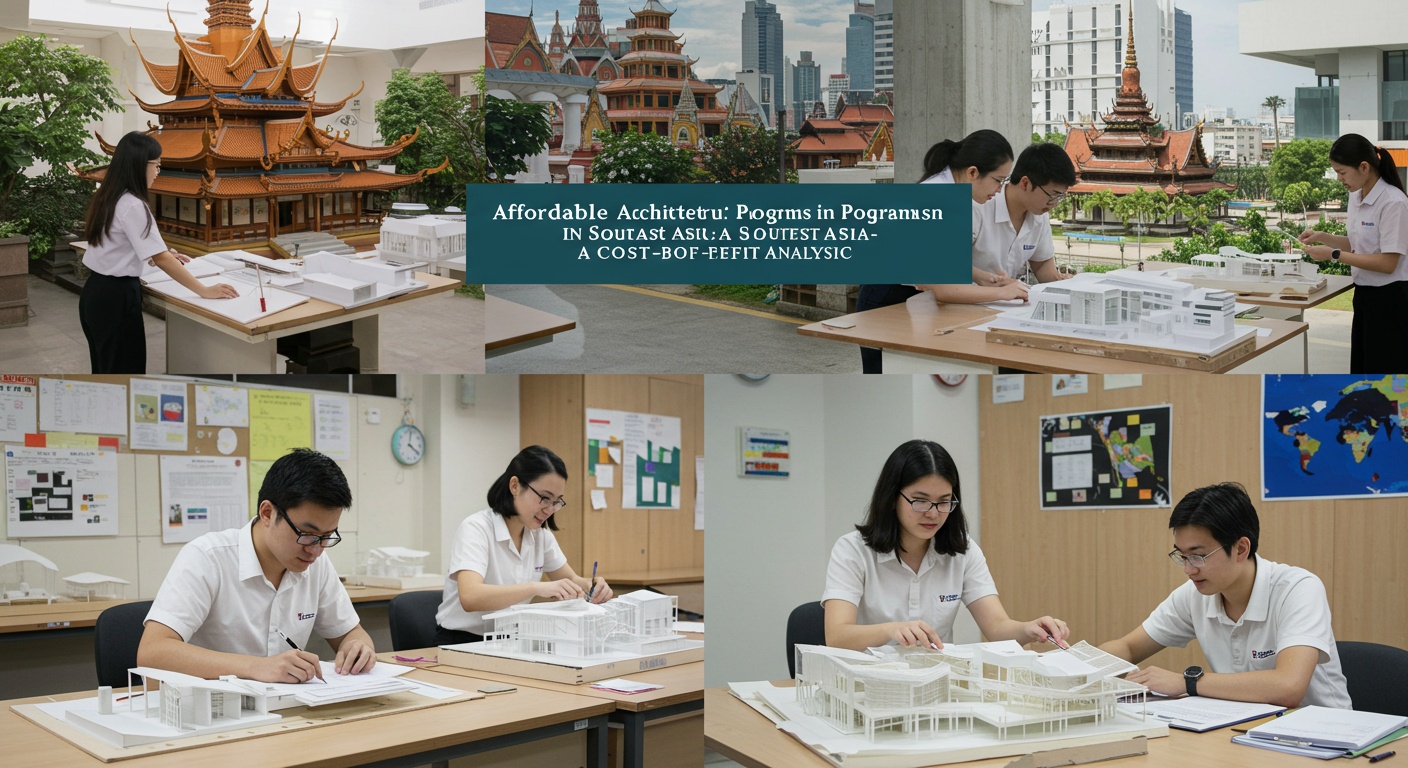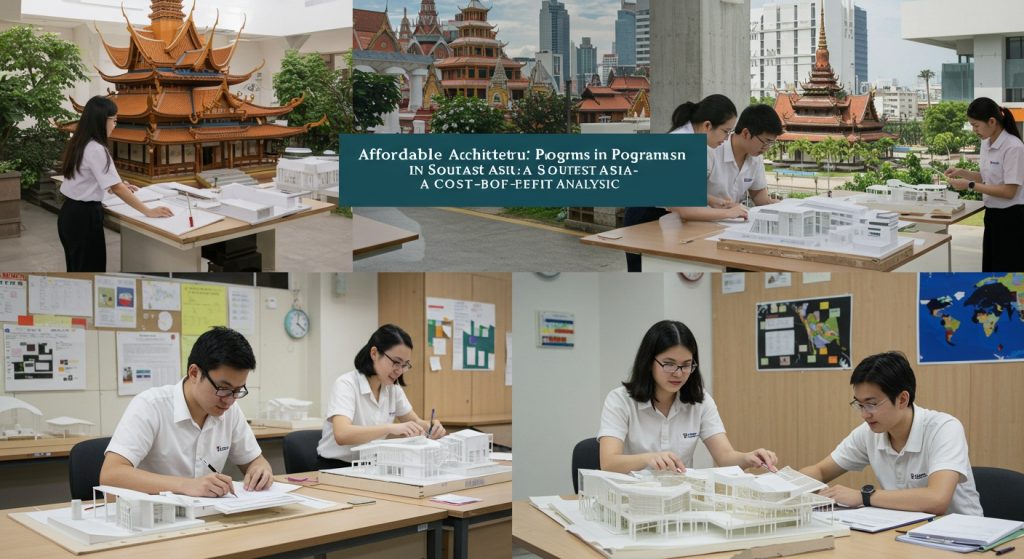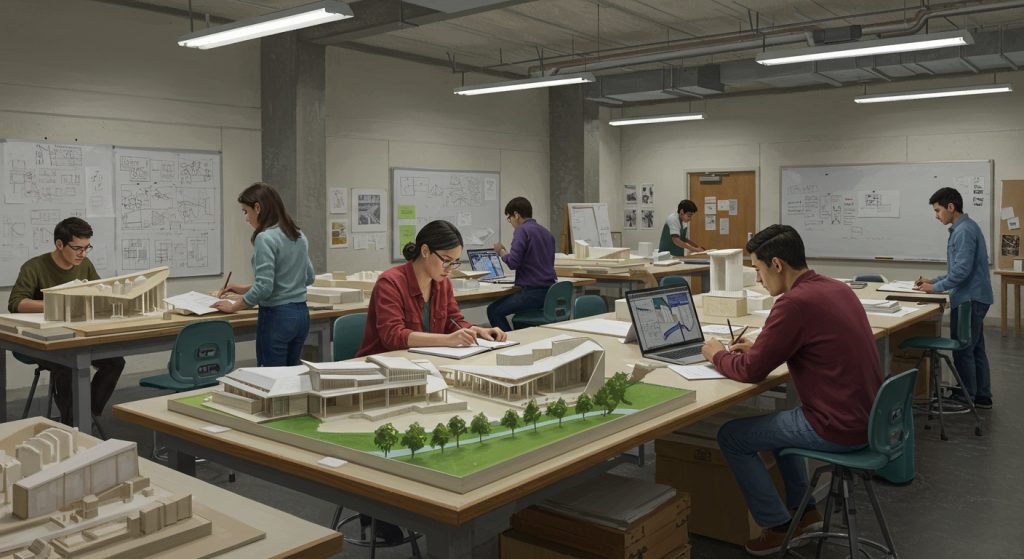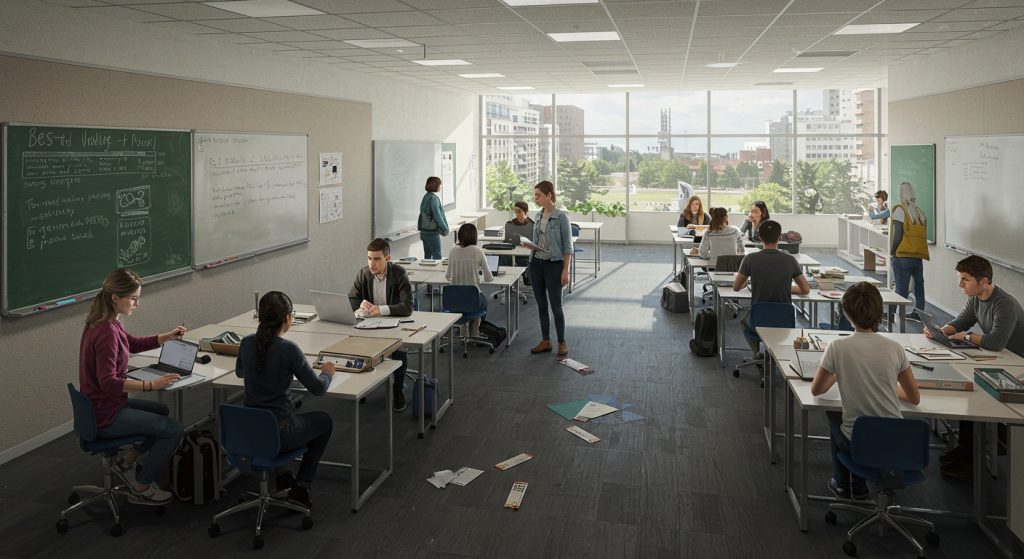Southeast Asia’s burgeoning urban landscape demands skilled architects, yet the path to professional qualification often presents a significant financial hurdle. This exploration delves into the landscape of affordable architecture programs across the region, spotlighting institutions in countries like Vietnam and Indonesia that are pioneering cost-effective educational models. We examine the delicate balance between tuition fees and program quality, considering factors such as faculty expertise, studio facilities. Industry connections. Crucially, we assess the return on investment, evaluating graduate employment rates and average starting salaries relative to program costs. By analyzing these critical metrics, we aim to provide prospective students with a comprehensive framework for making informed decisions about their architectural education, ultimately empowering them to pursue their passion without incurring crippling debt.

Understanding the Landscape of Architectural Education in Southeast Asia
Southeast Asia is emerging as a vibrant hub for architectural innovation, blending modern design principles with rich cultural heritage. Studying architecture in this region offers unique opportunities to learn about sustainable design practices adapted to tropical climates, urban planning challenges in rapidly developing cities. The preservation of historical landmarks. But, the cost of education can be a significant barrier. This section explores the factors influencing the affordability of architecture programs in Southeast Asia and defines key terms relevant to this field of study. Key terms to grasp include:
- Accreditation: This refers to the formal recognition of an architecture program by a professional body, ensuring that it meets certain quality standards. Accreditation is crucial for graduates seeking professional licensure and recognition in their home countries and internationally. Examples include accreditation by the Board of Architects in various Southeast Asian countries or international bodies like the RIBA (Royal Institute of British Architects).
- Tuition Fees: The direct cost of instruction and access to university resources. This varies widely between public and private universities and across different countries in the region.
- Cost of Living: This encompasses expenses such as accommodation, food, transportation. Personal expenses. It’s a significant factor influencing the overall affordability of studying architecture abroad.
- Scholarships and Financial Aid: These are financial awards that help reduce the burden of tuition fees and living expenses. Many universities and external organizations offer scholarships specifically for international students.
- Design Studio: A dedicated workspace where architecture students develop and refine their design projects. Access to well-equipped design studios is a crucial aspect of a quality architectural education.
- Internship Opportunities: Practical work experience in architectural firms, providing students with valuable skills and industry connections. The availability and quality of internship opportunities can greatly enhance the career prospects of graduates.
- Sustainable Design: An approach to design that minimizes environmental impact, conserves resources. Creates healthy and comfortable environments. This is increasingly crucial in the context of climate change and rapid urbanization.
Comparing Architecture Program Costs Across Southeast Asian Countries
The cost of architectural education varies considerably across Southeast Asian countries. This section provides a comparative analysis of tuition fees and living expenses in several key destinations, including Malaysia, Thailand, Indonesia, the Philippines. Vietnam. Malaysia: Malaysia offers a relatively affordable option for international students seeking quality architectural education. Tuition fees at public universities range from $3,000 to $6,000 USD per year, while private universities can charge between $6,000 and $12,000 USD. The cost of living is also relatively low, estimated at $500 to $800 USD per month. Thailand: Thailand is another popular destination for international students. Tuition fees at public universities range from $2,000 to $5,000 USD per year, while private universities can charge between $5,000 and $10,000 USD. The cost of living is similar to Malaysia, ranging from $500 to $800 USD per month. Indonesia: Indonesia offers some of the most affordable architecture programs in the region, especially at public universities. Tuition fees can be as low as $1,000 to $3,000 USD per year. But, the cost of living in major cities like Jakarta can be higher, ranging from $600 to $1,000 USD per month. The Philippines: Architecture programs in the Philippines are also relatively affordable, with tuition fees at public universities ranging from $1,500 to $4,000 USD per year. Private universities can charge between $4,000 and $8,000 USD. The cost of living is generally lower than in Malaysia and Thailand, ranging from $400 to $700 USD per month. Vietnam: Vietnam offers a rapidly developing architectural education sector with growing opportunities. Tuition fees at public universities range from $1,000 to $3,000 USD per year, while private universities can charge between $3,000 and $6,000 USD. The cost of living is among the lowest in the region, ranging from $300 to $600 USD per month. The following table summarizes the estimated costs:
| Country | Tuition Fees (USD/Year) – Public | Tuition Fees (USD/Year) – Private | Estimated Cost of Living (USD/Month) |
|---|---|---|---|
| Malaysia | $3,000 – $6,000 | $6,000 – $12,000 | $500 – $800 |
| Thailand | $2,000 – $5,000 | $5,000 – $10,000 | $500 – $800 |
| Indonesia | $1,000 – $3,000 | $3,000 – $7,000 | $600 – $1,000 |
| The Philippines | $1,500 – $4,000 | $4,000 – $8,000 | $400 – $700 |
| Vietnam | $1,000 – $3,000 | $3,000 – $6,000 | $300 – $600 |
Assessing Program Quality and Accreditation
While affordability is crucial, the quality of the architecture program is equally crucial. Accreditation serves as a benchmark for program quality, ensuring that it meets industry standards and prepares graduates for professional practice. Researching the accreditation status of a program is essential before making a decision. In Southeast Asia, accreditation standards vary by country. For example, in Malaysia, the Board of Architects Malaysia (LAM) accredits architecture programs. In the Philippines, the Commission on Higher Education (CHED) oversees accreditation. It’s crucial to check the specific accreditation requirements of the country where you plan to practice architecture after graduation. Beyond accreditation, consider the following factors when assessing program quality:
- Faculty Expertise: Look for programs with experienced faculty members who are actively involved in research and practice.
- Curriculum Relevance: Ensure that the curriculum covers essential topics such as architectural design, history, theory, technology. Professional practice. The curriculum should also incorporate contemporary issues such as sustainable design and digital fabrication.
- Studio Facilities: Access to well-equipped design studios is crucial for hands-on learning and project development.
- Internship Opportunities: Strong industry connections and internship opportunities can significantly enhance your career prospects.
- International Exposure: Programs that offer opportunities for international exchange programs or study tours can broaden your perspectives and enhance your global competitiveness.
Maximizing ROI: Career Prospects and Salary Expectations
The return on investment (ROI) of an architecture degree is an crucial consideration. While salaries vary depending on experience, location. Specialization, a degree from a reputable architecture program in Southeast Asia can lead to rewarding career opportunities. Graduates can pursue careers in:
- Architectural Firms: Working on a variety of design projects, from residential buildings to commercial complexes.
- Urban Planning Agencies: Contributing to the planning and development of cities and communities.
- Construction Companies: Overseeing the design and construction of buildings and infrastructure projects.
- Government Agencies: Working on public sector projects, such as schools, hospitals. Government buildings.
- Real Estate Development Companies: Developing and managing real estate projects.
- Academia: Teaching and conducting research in architecture.
Entry-level salaries for architects in Southeast Asia typically range from $8,000 to $15,000 USD per year. With experience and specialization, salaries can increase significantly, reaching $30,000 USD or more per year. The demand for architects is expected to grow in the coming years, driven by rapid urbanization and infrastructure development in the region. This makes Southeast Asia a promising destination for aspiring architects seeking affordable education and rewarding career opportunities. When considering your ROI, it’s also worth exploring Budget-Friendly Finance Degrees: ROI in Southeast Asia to interpret financial investment strategies relevant to the region.
Scholarships and Financial Aid Opportunities
Numerous scholarships and financial aid opportunities are available to support international students pursuing architecture degrees in Southeast Asia. These scholarships can significantly reduce the financial burden of tuition fees and living expenses. Some popular scholarship programs include:
- ASEAN Scholarships: Offered by various governments and organizations to promote education and cultural exchange within the ASEAN region.
- University-Specific Scholarships: Many universities offer scholarships specifically for international students, based on academic merit or financial need.
- Government Scholarships: Some governments offer scholarships to students from developing countries to study in Southeast Asia.
- Private Foundation Scholarships: Various private foundations and organizations offer scholarships for students pursuing architecture and related fields.
To maximize your chances of securing a scholarship, research the eligibility criteria, application deadlines. Required documents well in advance. Prepare a strong application that highlights your academic achievements, design skills. Passion for architecture. Consider also seeking guidance from your university’s international student office or educational advisors.
Real-World Applications and Use Cases
Studying architecture in Southeast Asia provides unique opportunities to learn about design solutions tailored to the region’s specific challenges and opportunities. These include:
- Tropical Architecture: Designing buildings that are adapted to hot and humid climates, using passive cooling strategies, natural ventilation. Shading devices.
- Sustainable Design: Incorporating sustainable materials, energy-efficient technologies. Water conservation measures in building design.
- Urban Planning: Addressing the challenges of rapid urbanization, such as traffic congestion, housing shortages. Environmental degradation.
- Heritage Conservation: Preserving and restoring historical buildings and cultural landmarks.
- Community Engagement: Involving local communities in the design process to ensure that buildings meet their needs and aspirations.
For example, architects in Southeast Asia are increasingly using bamboo as a sustainable building material, leveraging its strength, flexibility. Abundance. They are also incorporating traditional building techniques, such as raised floors and pitched roofs, to enhance natural ventilation and protect buildings from flooding. In urban areas, architects are designing high-density housing solutions that incorporate green spaces and promote social interaction. By studying architecture in Southeast Asia, you can gain valuable skills and knowledge that are relevant to the region’s specific context and contribute to its sustainable development.
Conclusion
Embarking on an architecture degree in Southeast Asia is more than just choosing a program; it’s an investment in a future shaped by innovation and cultural sensitivity. Having explored the landscape of affordable architecture programs, remember that the true value lies not just in the tuition fee. In the program’s alignment with your aspirations and the practical skills you gain. As someone who initially struggled with balancing theoretical knowledge and real-world application, I can attest to the importance of seeking out programs that prioritize hands-on experience through internships or studio projects. The road ahead for aspiring architects in Southeast Asia is bright, fueled by rapid urbanization and a growing demand for sustainable and culturally relevant designs. To maximize your ROI, consider specializing in areas like green building design or urban planning, which are highly sought after in the region. Before committing, connect with alumni and current students to get a realistic picture of the program’s strengths and weaknesses. Ultimately, success in architecture hinges on your passion, creativity. Willingness to adapt to the ever-evolving needs of society. Embrace the challenges. You’ll be well on your way to shaping the future of Southeast Asia’s built environment.
FAQs
So, I’m dreaming of being an architect. My bank account isn’t exactly screaming ‘Ivy League.’ Are there actually affordable architecture programs in Southeast Asia that are worth it?
Absolutely! You’re in luck. Southeast Asia offers some fantastic architecture programs that won’t break the bank. Think Malaysia, Thailand, Indonesia. The Philippines – they all have universities with strong architecture schools and significantly lower tuition fees than, say, schools in the US or Europe. The trick is doing your homework to make sure the program aligns with your career goals.
Okay, ‘affordable’ is relative. Roughly, what kind of tuition fees are we talking about per year compared to the West?
Good question! While it varies by country and university, you could be looking at tuition fees anywhere from $2,000 to $8,000 USD per year. Compared to the $30,000+ you might see in the US or the UK, that’s a HUGE difference. Keep in mind this doesn’t include living expenses. Even those are generally lower in Southeast Asia.
What about the quality of education? Will I be getting a ‘second-rate’ architecture education if I go this route?
Not necessarily at all! Many universities in Southeast Asia have internationally recognized architecture programs with experienced faculty and modern facilities. Look for programs that are accredited by local or international architecture boards – that’s a good sign of quality. Plus, being in Southeast Asia exposes you to unique architectural styles and challenges, which can be a real advantage.
Aside from tuition, what other costs should I be factoring in when planning my budget?
Definitely don’t forget about living expenses! Think accommodation (dorm or apartment), food, transportation, visa fees, books. Studio supplies (those can add up!). Also, consider cultural excursions and travel within the region – it’s part of the experience! Research the cost of living in the specific city where you’ll be studying.
Are there any scholarship opportunities available for international students studying architecture in Southeast Asia?
Yes, there are! It’s worth researching scholarships offered by the universities themselves, as well as government scholarships from your home country or the host country. Websites like Scholarship Positions and the university’s international student office are great places to start your search. Early application is key!
What kind of job opportunities can I expect after graduating from an architecture program in Southeast Asia?
It depends on where you want to work. If you want to stay in Southeast Asia, there are growing opportunities in urban development, sustainable design. Tourism-related architecture. If you want to return to your home country, having international experience can be a real asset. You might need to get your degree recognized or take additional exams depending on local regulations.
Okay, this all sounds promising. What’s the biggest ‘catch’ or potential downside I should be aware of?
Honestly, the biggest hurdle for some might be the cultural adjustment. Living and studying in a new country, especially one with a different language and customs, can be challenging. Also, ensure the program’s teaching style aligns with your learning preference. Some might find the teaching method a little different from what they are used to.



